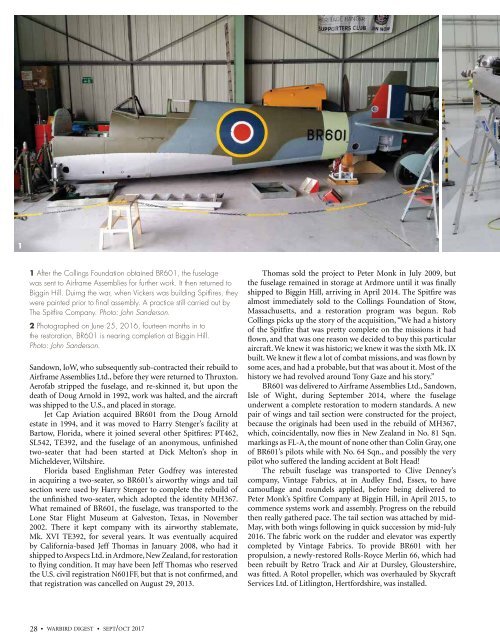WD74W2
You also want an ePaper? Increase the reach of your titles
YUMPU automatically turns print PDFs into web optimized ePapers that Google loves.
1<br />
1 After the Collings Foundation obtained BR601, the fuselage<br />
was sent to Airframe Assemblies for further work. It then returned to<br />
Biggin Hill. Duirng the war, when Vickers was building Spitfires, they<br />
were painted prior to final assembly. A practice still carried out by<br />
The Spitfire Company. Photo: John Sanderson.<br />
2 Photographed on June 25, 2016, fourteen months in to<br />
the restoration, BR601 is nearing completion at Biggin Hill.<br />
Photo: John Sanderson.<br />
Sandown, IoW, who subsequently sub-contracted their rebuild to<br />
Airframe Assemblies Ltd., before they were returned to Thruxton.<br />
Aerofab stripped the fuselage, and re-skinned it, but upon the<br />
death of Doug Arnold in 1992, work was halted, and the aircraft<br />
was shipped to the U.S., and placed in storage.<br />
Jet Cap Aviation acquired BR601 from the Doug Arnold<br />
estate in 1994, and it was moved to Harry Stenger’s facility at<br />
Bartow, Florida, where it joined several other Spitfires: PT462,<br />
SL542, TE392, and the fuselage of an anonymous, unfinished<br />
two-seater that had been started at Dick Melton’s shop in<br />
Micheldever, Wiltshire.<br />
Florida based Englishman Peter Godfrey was interested<br />
in acquiring a two-seater, so BR601’s airworthy wings and tail<br />
section were used by Harry Stenger to complete the rebuild of<br />
the unfinished two-seater, which adopted the identity MH367.<br />
What remained of BR601, the fuselage, was transported to the<br />
Lone Star Flight Museum at Galveston, Texas, in November<br />
2002. There it kept company with its airworthy stablemate,<br />
Mk. XVI TE392, for several years. It was eventually acquired<br />
by California-based Jeff Thomas in January 2008, who had it<br />
shipped to Avspecs Ltd. in Ardmore, New Zealand, for restoration<br />
to flying condition. It may have been Jeff Thomas who reserved<br />
the U.S. civil registration N601FF, but that is not confirmed, and<br />
that registration was cancelled on August 29, 2013.<br />
Thomas sold the project to Peter Monk in July 2009, but<br />
the fuselage remained in storage at Ardmore until it was finally<br />
shipped to Biggin Hill, arriving in April 2014. The Spitfire was<br />
almost immediately sold to the Collings Foundation of Stow,<br />
Massachusetts, and a restoration program was begun. Rob<br />
Collings picks up the story of the acquisition, “We had a history<br />
of the Spitfire that was pretty complete on the missions it had<br />
flown, and that was one reason we decided to buy this particular<br />
aircraft. We knew it was historic; we knew it was the sixth Mk. IX<br />
built. We knew it flew a lot of combat missions, and was flown by<br />
some aces, and had a probable, but that was about it. Most of the<br />
history we had revolved around Tony Gaze and his story.”<br />
BR601 was delivered to Airframe Assemblies Ltd., Sandown,<br />
Isle of Wight, during September 2014, where the fuselage<br />
underwent a complete restoration to modern standards. A new<br />
pair of wings and tail section were constructed for the project,<br />
because the originals had been used in the rebuild of MH367,<br />
which, coincidentally, now flies in New Zealand in No. 81 Sqn.<br />
markings as FL-A, the mount of none other than Colin Gray, one<br />
of BR601’s pilots while with No. 64 Sqn., and possibly the very<br />
pilot who suffered the landing accident at Bolt Head!<br />
The rebuilt fuselage was transported to Clive Denney’s<br />
company, Vintage Fabrics, at in Audley End, Essex, to have<br />
camouflage and roundels applied, before being delivered to<br />
Peter Monk’s Spitfire Company at Biggin Hill, in April 2015, to<br />
commence systems work and assembly. Progress on the rebuild<br />
then really gathered pace. The tail section was attached by mid-<br />
May, with both wings following in quick succession by mid-July<br />
2016. The fabric work on the rudder and elevator was expertly<br />
completed by Vintage Fabrics. To provide BR601 with her<br />
propulsion, a newly-restored Rolls-Royce Merlin 66, which had<br />
been rebuilt by Retro Track and Air at Dursley, Gloustershire,<br />
was fitted. A Rotol propeller, which was overhauled by Skycraft<br />
Services Ltd. of Litlington, Hertfordshire, was installed.<br />
28 • warbird digest • sept/oct 2017


